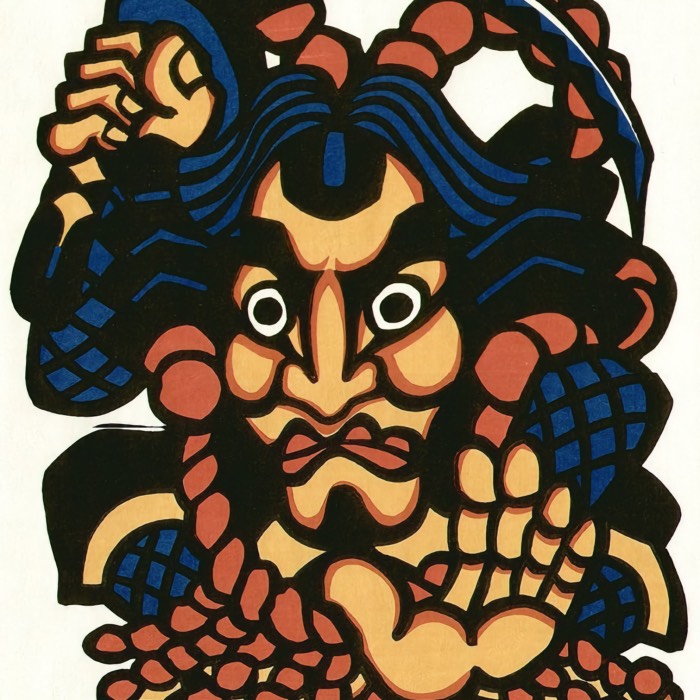Shirō Kasamatsu: The Nihonga and Shin Hanga artist
Shirō Kasamatsu (1898–1991) was a versatile painter and printmaker and a leading figure in the Shin Hanga movement. Known for his meticulous attention to detail and serene landscapes, Kasamatsu’s work blends traditional Japanese aesthetics with modern influences, capturing the beauty of Japan’s natural and urban environments. His prints are celebrated for their emotional resonance and timeless appeal, making him one of the most renowned artists of the 20th century.
 Night Rain at the Shinobazu Pond, Shirō Kasamatsu, 1938. Source: ukiyo-e.orgꜛ
Night Rain at the Shinobazu Pond, Shirō Kasamatsu, 1938. Source: ukiyo-e.orgꜛ
Biography
Shirō Kasamatsu (笠松紫郎) was born on January 11, 1898, in Tokyo, Japan. Growing up in a period of rapid modernization and cultural change, Kasamatsu was exposed to both traditional Japanese arts and the emerging modern influences that would later shape his artistic career. His interest in art was apparent from a young age, and he pursued formal training to hone his skills.
 In front, left side: Kasamatsu Shirō, right side Shōzaburō Watanabe. In the back from left: Moriyama (an employees of Watanabe), Kawase Hasui, collector Robert Muller and his wife Inge, Itō Shinsui and his wife (1941). Source: Wikimedia Commonsꜛ
In front, left side: Kasamatsu Shirō, right side Shōzaburō Watanabe. In the back from left: Moriyama (an employees of Watanabe), Kawase Hasui, collector Robert Muller and his wife Inge, Itō Shinsui and his wife (1941). Source: Wikimedia Commonsꜛ
Kasamatsu began his artistic journey under the mentorship of Kaburagi Kiyokata, a renowned Nihonga painter who specialized in bijin-ga (pictures of beautiful women). Kiyokata was a prominent figure in the Nihonga movement, and under his guidance, Kasamatsu developed a deep appreciation for traditional Japanese painting techniques and aesthetics. This early influence would play a significant role in Kasamatsu’s later work, particularly in his approach to landscape and figure painting.
In the early 1920s, Kasamatsu was introduced to Watanabe Shōzaburō, the influential publisher who was a driving force behind the Shin Hanga movement. Recognizing Kasamatsu’s talent, Watanabe encouraged him to create woodblock prints that blended traditional Japanese themes with modern sensibilities. This collaboration marked the beginning of Kasamatsu’s prolific career in the Shin Hanga movement.
Kasamatsu’s work, characterized by its versatility and attention to detail, spanned a wide range of subjects, including landscapes, bijin-ga, and scenes of everyday life. His prints gained popularity both in Japan and internationally, contributing to the global success of the Shin Hanga movement.
In the 1950s, Kasamatsu began to work more independently, producing prints that he self-published, which allowed him greater artistic freedom. His later works continued to reflect his deep connection to traditional Japanese culture while also exploring new themes and techniques.
Shirō Kasamatsu passed away in 1991, leaving behind a rich legacy as one of the most versatile and innovative artists of the Shin Hanga movement.
Artistic style and significance
Shirō Kasamatsu is celebrated for his versatility as an artist, capable of capturing the beauty of both the natural world and the human form. His work is characterized by a blend of traditional Japanese aesthetics and modern artistic influences, making him a key figure in the Shin Hanga movement.
Landscapes: A harmonious blend of tradition and modernity
Kasamatsu’s landscapes are among his most well-known works, celebrated for their serene beauty and meticulous attention to detail. He often depicted scenes of rural Japan, traditional temples, and quiet urban streets, capturing the tranquil atmosphere of these settings. His use of color and composition reflects a deep understanding of traditional Japanese painting techniques, while also incorporating elements of Western realism and perspective.
One of the defining characteristics of Kasamatsu’s landscape prints is his ability to convey a strong sense of place and mood. Whether depicting a snow-covered village or a tranquil riverside scene, Kasamatsu’s prints evoke a feeling of peace and nostalgia, transporting the viewer to the quiet, often idyllic locations he portrayed. His landscapes are noted for their clarity and balance, with each element carefully composed to create a harmonious whole.
Bijin-ga: The elegance of traditional beauty
In addition to landscapes, Kasamatsu also produced a number of bijin-ga prints, which depict beautiful women in various poses and settings. These works reflect the influence of his early training under Kaburagi Kiyokata, as well as his ability to blend traditional and modern elements in his art.
Kasamatsu’s bijin-ga are characterized by their elegance and grace, with a particular focus on the details of the women’s clothing and the subtle expressions on their faces. His use of soft, delicate lines and a refined color palette adds to the overall sense of beauty and poise in these prints. While less prolific in bijin-ga than in landscapes, Kasamatsu’s contributions to the genre are nonetheless significant, showcasing his versatility as an artist.
Everyday scenes: Capturing the essence of Japanese life
Kasamatsu also created prints that depicted scenes of everyday life, often focusing on the quiet, contemplative moments that characterize traditional Japanese culture. These works reflect his deep connection to the customs and traditions of Japan, as well as his ability to capture the simple yet profound beauty of daily life.
His prints often feature people engaged in routine activities, such as fishing, walking along a riverbank, or enjoying the changing seasons. These scenes are rendered with the same attention to detail and composition that characterizes his landscapes, creating a sense of continuity between his depictions of nature and human life.
Transition to self-publishing: Artistic freedom and innovation
In the 1950s, Kasamatsu began to transition away from his collaboration with Watanabe Shōzaburō and started self-publishing his prints. This shift allowed him greater artistic freedom, enabling him to explore new themes and techniques that were not constrained by the commercial demands of the Shin Hanga movement.
During this period, Kasamatsu experimented with different color schemes, compositions, and subject matter, further expanding his artistic repertoire. His later works are notable for their bold use of color and innovative approaches to traditional themes, reflecting his ongoing commitment to artistic growth and exploration.
Impact and legacy
Shirō Kasamatsu’s contribution to the Shin Hanga movement was significant, particularly in the realm of landscape art. His ability to capture the beauty and tranquility of Japan’s natural and urban environments made his prints highly popular both in Japan and abroad. His versatility as an artist, capable of creating works in a wide range of genres, further cemented his reputation as one of the leading figures in the Shin Hanga movement.
Kasamatsu’s later work as a self-published artist also highlights his dedication to artistic innovation and his willingness to push the boundaries of traditional woodblock printing. His prints continue to be celebrated for their beauty, craftsmanship, and the emotional resonance they evoke.
Notable Works
Throughout his prolific career, Shirō Kasamatsu produced numerous works that are considered masterpieces of the Shin Hanga movement. Here are some of his most notable prints:


Left: Shuzenji onsen, Shirō Kasamatsu, 1937. Source: Wikimedia Commonsꜛ (license: public domain) – Right: The Large Lantern in the Kannon Temple in Asakusa, Shirō Kasamatsu, 1934. Source: Wikimedia Commonsꜛ (license: public domain)


Left: The edge of Shinobazu pond during a foggy evening, Shirō Kasamatsu, 1932. Source: Wikimedia Commonsꜛ (license: public domain) – Right: Front of the Engaku-ji in Kamakura, Shirō Kasamatsu, 1953. Source: ukiyo-e.orgꜛ


Left: House At Okutama, Shirō Kasamatsu, 1955. Source: ukiyo-e.orgꜛ – Right: Middle Gate of Rokugien - Tokyo Meien, Shirō Kasamatsu, 1953. Source: ukiyo-e.orgꜛ


Left: Char Fishing in the rocks, Shirō Kasamatsu, 1956. Source: ukiyo-e.orgꜛ – Right: Carp, Shirō Kasamatsu, 1957. Source: ukiyo-e.orgꜛ
 Imai Bridge, Shirō Kasamatsu, 1939. Source: ukiyo-e.orgꜛ
Imai Bridge, Shirō Kasamatsu, 1939. Source: ukiyo-e.orgꜛ


Left: Long-tailed Rooster, Shirō Kasamatsu, 1930-1935. Source: ukiyo-e.orgꜛ – Right: Shimoda, Shirō Kasamatsu, 1962. Source: ukiyo-e.orgꜛ


Left: Yanagaibashi Fukin (The area around Yanagibashi), Shirō Kasamatsu, 1954. Source: ukiyo-e.orgꜛ – Right: Kegon Waterfall, Shirō Kasamatsu, 1953. Source: ukiyo-e.orgꜛ


Left: Shinshu Hotsprings, Shubu, Nagano, Shirō Kasamatsu, 1948. Source: ukiyo-e.orgꜛ – Right: Remaining Light at Minakami, Shirō Kasamatsu, 1958. Source: ukiyo-e.orgꜛ


Left: Evening Rain, Shinobazu Pond (print variant), Shirō Kasamatsu, 1938. Source: ukiyo-e.orgꜛ – Right: Tea Ceremony, Shirō Kasamatsu, 1949. Source: ukiyo-e.orgꜛ


Left: Kinokunisaka In The Rainy Season, Shirō Kasamatsu, 1938. Source: ukiyo-e.orgꜛ – Right: Summer Night, Shirō Kasamatsu, 1957. Source: ukiyo-e.orgꜛ


Left: Pagoda in Evening Rain, Shirō Kasamatsu, 1932. Source: ukiyo-e.orgꜛ – Right: Rice Planting, Shirō Kasamatsu. Source: ukiyo-e.orgꜛ


Left: Mt. Fuji from Yoshida, Shirō Kasamatsu, 1958. Source: ukiyo-e.orgꜛ – Right: Benkei Bridge, Shirō Kasamatsu, 1953. Source: ukiyo-e.orgꜛ


Left: Birds and Fish, Shirō Kasamatsu. Source: ukiyo-e.orgꜛ – Right: Matsushima Godaido Pagoda, Shirō Kasamatsu, 1954. Source: ukiyo-e.orgꜛ


Left: Sanmon Gate of Zojo Temple, from Eight Views of Tokyo, Shirō Kasamatsu, 1953. Source: ukiyo-e.orgꜛ – Right: Iizaka, Shirō Kasamatsu, 1954. Source: ukiyo-e.orgꜛ


Left: Dusk at Minakami, Shirō Kasamatsu. Source: ukiyo-e.orgꜛ – Right: Yomei Gate in Light Rain, Shirō Kasamatsu, 1935. Source: ukiyo-e.orgꜛ
 Flounder (Karei), Shirō Kasamatsu, 1957. Source: ukiyo-e.orgꜛ
Flounder (Karei), Shirō Kasamatsu, 1957. Source: ukiyo-e.orgꜛ
 Sea of Shizuura, Numazu, Shirō Kasamatsu, 1938. Source: ukiyo-e.orgꜛ
Sea of Shizuura, Numazu, Shirō Kasamatsu, 1938. Source: ukiyo-e.orgꜛ


Left: Suwa Shrine in Nippori, Shirō Kasamatsu, 1932. Source: ukiyo-e.orgꜛ – Right: Inokashika-Inokashira Shrine, from the series Eight Views of Tokyo, Shirō Kasamatsu, 1953. Source: ukiyo-e.orgꜛ


Left: Cherry Blossoms at Heian Jingu Shrine, Shirō Kasamatsu, 1937. Source: ukiyo-e.orgꜛ – Right: Morning at the Spa: Nozawa, Shirō Kasamatsu, 1933. Source: ukiyo-e.orgꜛ
 Hongo Akamon no Yuki (Hongo Red Gate in Snow), Shirō Kasamatsu, 1935. Source: ukiyo-e.orgꜛ
Hongo Akamon no Yuki (Hongo Red Gate in Snow), Shirō Kasamatsu, 1935. Source: ukiyo-e.orgꜛ


Left: Rising Moon at Katase River, Shirō Kasamatsu, 1953. Source: ukiyo-e.orgꜛ – Right: Katori Shrine, Shirō Kasamatsu, 1954. Source: ukiyo-e.orgꜛ


Left: Angel fish (Chouchouuo), Shirō Kasamatsu, 1967. Source: ukiyo-e.orgꜛ – Right: Shinsentei Arbor in Rikugien Garden, Shirō Kasamatsu. Source: ukiyo-e.orgꜛ
 Unknown title, Shirō Kasamatsu, 1939. Source: ukiyo-e.orgꜛ
Unknown title, Shirō Kasamatsu, 1939. Source: ukiyo-e.orgꜛ


Left: Calm Morning, Shirō Kasamatsu, 1933. Source: ukiyo-e.orgꜛ – Right: Evening Rain Shinobazu Pond, Shirō Kasamatsu, 1938. Source: ukiyo-e.orgꜛ


Left: Temple, Shirō Kasamatsu, 1976. Source: ukiyo-e.orgꜛ – Right: Sleeping goats (Nemuru koyagi), Shirō Kasamatsu, 1958. Source: ukiyo-e.orgꜛ


Left: Snow, Shirō Kasamatsu, 1957. Source: ukiyo-e.orgꜛ – Right: Tea House, Shirō Kasamatsu, 1950-1960s. Source: ukiyo-e.orgꜛ
 Castle in Red Sunset, Shirō Kasamatsu, 1982. Source: ukiyo-e.orgꜛ
Castle in Red Sunset, Shirō Kasamatsu, 1982. Source: ukiyo-e.orgꜛ
 Castle, Shirō Kasamatsu, 1980-1990s. Source: ukiyo-e.orgꜛ
Castle, Shirō Kasamatsu, 1980-1990s. Source: ukiyo-e.orgꜛ

Red Gate at Tokyo University, Shirō Kasamatsu, 1957. Source: ukiyo-e.orgꜛ


Left: Morning Waves, Shirō Kasamatsu, 1956. Source: ukiyo-e.orgꜛ – Right: Thawing (Yukidoke), Shirō Kasamatsu, 1957. Source: ukiyo-e.orgꜛ


Left: Mother and Child, Shirō Kasamatsu, 1930s. Source: ukiyo-e.orgꜛ – Right: Mt. Fuji, Shirō Kasamatsu, 1950s. Source: ukiyo-e.orgꜛ


Left: Tide (Shiodoki), Shirō Kasamatsu, 1964. Source: ukiyo-e.orgꜛ – Right: Bird Cage, Shirō Kasamatsu, 1957. Source: ukiyo-e.orgꜛ
Conclusion
Shirō Kasamatsu stands out as one of the most versatile and innovative artists of the Shin Hanga movement. His ability to capture the beauty of Japan’s landscapes, the elegance of traditional bijin-ga, and the quiet moments of everyday life made his work widely appreciated both in Japan and abroad. Kasamatsu’s dedication to his craft, his willingness to explore new themes and techniques, and his transition to self-publishing in his later years demonstrate his commitment to artistic growth and innovation. Today, his prints remain highly valued by collectors and continue to be celebrated for their beauty, craftsmanship, and emotional resonance.
References and further reading
- Chris Uhlenbeck, Jim Dwinger, Philo Ouweleen, Shin Hanga - Die »Neuen Drucke« Japans 1900-1950, 2022, Hatje Cantz, ISBN: 9783775752190
- viewingjapaneseprints.netꜛ
- Kasamtasu Shirō on ukiyo-e.orgꜛ












comments